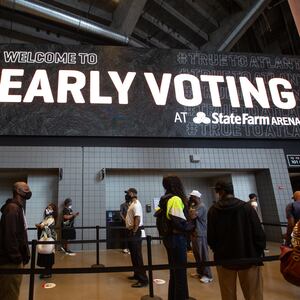As former Vice President Joe Biden rides consistently high in national polls and internal numbers indicate that red-leaning states are tantalizingly close to abandoning President Donald Trump in next week’s election, the Democratic nominee’s campaign is feeling the same rush that Clinton did—and they’re going for it.
With only seven days until Election Day, the Biden campaign has announced a rash of in-person campaign appearances in states that haven’t voted for a Democratic presidential candidate in decades, even generations. Dr. Jill Biden is headed to Macon and Savannah on Monday; Biden himself will be in Atlanta the next day; and Sen. Kamala Harris will be in multiple cities in Texas—yes, that Texas—on Friday.
“The bottom line is we’re focusing on every state,” Sen. Kamala Harris, the Democratic vice presidential nominee, told a press pooler in Detroit on Sunday when asked if the campaign should be pursuing reach states instead of going all-in on the Rust Belt. “We are working to earn the vote of every American, regardless of where they live.”
ADVERTISEMENT
Ever since Election Night 2016 annihilated their confidence in polls, pundits and the left-leaning information ecosystem that had assured them that victory was in the bag, Democrats have been terrified of repeating Hillary Clinton’s perceived fatal error of neglecting the industrial Midwest in favor of expanding the electoral map. If Republicans have been lulled into a potentially false sense of security that the polls in 2020 will be just as wrong as the polls in 2016, Democrats are anxious to the point of post-traumatic stress about the same thing.
Internally, part of the strategy behind deploying the campaign’s most important principals to states that would have been laughably out of reach for any Democrat in recent cycles is to expand the so-called “Road to 270” to include as many routes as possible. Although the Biden campaign has been candid that its most likely path to electoral victory is by winning back the so-called “Blue Wall” states in the Rust Belt—Michigan, Pennsylvania and Wisconsin—the pursuit of other electoral strategies removes the pressure from making the industrial Midwest a must-win.
“There's also another pathway that's very possible for us—we could lose those states and win a Sun Belt pathway, which does include Arizona and Nevada; it does include North Carolina and Florida and also Georgia,” campaign manager Jen O’Malley Dillon said in a state-of-the-race call with top campaign donors last week, a recording of which was obtained by The Daily Beast.
O’Malley Dillon has long been bullish on Arizona, a sentiment she repeated during the call, but told donors that the record-setting early voting in Georgia, which hasn’t voted for a Democratic presidential candidate since 1992, particularly among young voters and Black voters, has encouraged them to increase investment in the state.
“Georgia is a state that really was in the ‘expansion bucket’ of the battlegrounds,” O’Malley Dillon said, but “we have seen it come in very strong with early vote, a much higher number of young early voters, early voters of color. So there’s just real value in us continuing to play that state… we think that it’s truly in play.”
Beyond the Sun Belt pathway, however, lies the great lost jewel of Democratic politics: Texas. Once a mainstay of the party’s electoral map, the Lone Star State has been a Republican stronghold since 1976, and hasn’t elected a statewide Democrat since 1994. Winning it back would amount to a titanic repudiation of the Trump administration—and open up a battleground that could make Republican presidential aspirations borderline impossible in the future.
“The change in demographics and economics, along with a strong unified message and collaboration with the state and county party are a few reasons why we feel this election cycle will have a different outcome,” said Angelica Luna-Kaufman, a communications strategist for the Democratic Party in Harris County, home to Houston and more than 4 million Texans. “These are unprecedented times and cannot be compared to any other election in history—Biden’s messaging on saving the soul of this country resonates with Democrats in Texas.”
But while polling in Georgia and Texas has increasingly indicated the kinds of margins more common in swing states like Florida or Ohio, with individual surveys like the Quinnipiac University poll showing Biden and Trump locked in a dead heat, the Biden campaign is internally more circumspect about their accuracy—while still promising to run through the tape.
“Texas is a place that is a little bit harder for us to monitor because we’ve never actually had to before, in a presidential race,” O’Malley Dillon, who ran Beto O’Rourke’s near-miss campaign for U.S. Senate in Texas two years ago, said on the donor call. “We’re still trying to work through that, but we are seeing massive turnout in Texas… and I would say, continuing to focus on the lower-propensity voters to make sure that they’re trying to vote early to give us a more efficient bucket of people to go to for election day is job No. 1.”






